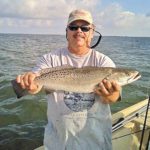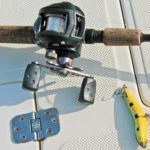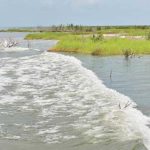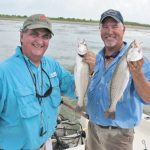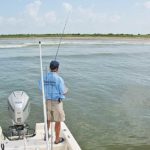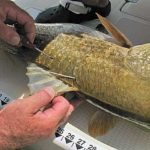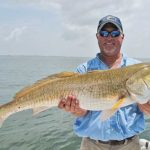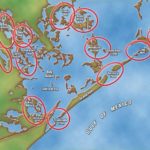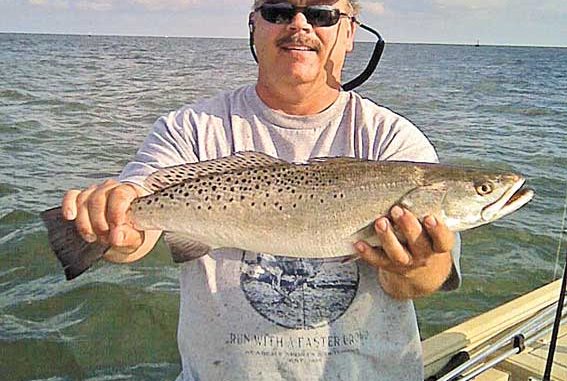
Trout fishing dies in Grand Isle after Labor Day, right? Umm, not exactly.
According to popular thought, September is the last hurrah for speckled trout anglers who fish out of Grand Isle. It’s almost an accepted maxim: “When Labor Day is over, so is the trout season on Grand Isle.”
But is it?
That’s what I was aiming to find out when I started calling a few Grand Isle charter captains. I wanted to talk and plan a trip with someone who fishes the island all year round. Some guides move around and fish one place during the spring and summer and another place in the fall and winter.
Not that anything is wrong with that, but I wanted to see if the old maxim is true. Do the specks vanish in the fall and winter? Or can you catch trout all year long from Grand Isle?
I figured to find out, and I needed to line up a year-round Grand Isle guide to take me. Normally, lining up a trip to do a feature is a lot like picking satsumas off the neighbor’s tree. I just shake the branches and see what falls off.
Usually when I want to fish Grand Isle I call Buggy over at Bridgeside Marina, and he rounds up a few guides and has them pick straws. Short straw loses, and has to take me. My inclination was to call Capt. Herk Bergeron, who fit the bill and had fished with me before and survived. But since I’d just done a story with him, I thought I’d bother somebody else.
So I made a few calls. The first captain I had lined up cancelled two trips (high winds, low probability of catching fish) and then quit returning my calls. Maybe he thought I was bad luck.
The second captain I lined up cancelled twice (same problem, but even worse winds combined with a high probability of thunderstorms). Then he got called out of state for a family emergency. Now even I was wondering about the bad luck thing.
But on my third attempt, I scored a trip with Capt. Dee Price (225-572-8927), who’d never met me and agreed to take me fishing before he knew what he was getting into. We met at Bridgeside Marina, where Buggy loaded us up with some prime croakers, and Price pointed the bow of his 24-foot bay boat through the legs of the bridge and toward a stretch of the beach where he’d been on a good trout bite.
We had just passed the new Wildlife and Fisheries building, and were talking about how great the speckled trout action had been all summer long. We were anticipating a great trip, and Price actually seemed excited to have me aboard.
That’s when his steering wheel mechanism mysteriously broke, leaving him with no way to steer the boat. It was one of those unexplainable occurrences, unless bad luck is an explanation. Thankfully, the steering didn’t go out when we were zipping through the legs of the bridge, nor did it lock in a 180 and throw us out the boat. But it did freeze the motor in a cockeyed position, and absolutely could not be turned, so all we could do was putt-putt in wide circles. Pricee decided to start trolling with the trolling motor back toward the marina, which would take quite a while, and he asked me what I wanted to do.
“Make lemonade,” I answered. “When life hands you lemons, you make lemonade, right?”
We both believed we could still salvage a good trip, even though it was nearly 8 a.m. and we were burning daylight.
Price got busy on the phone, trying to line up either a boat to borrow or another captain to take us fishing, and as luck would have it, he found Bergeron available and willing to come bail us out of our dilemma. Fortunately, we were close to Bergeron’s dock, and were able to troll to it and tie off the boat. We transferred our live bait and gear, and Price and I climbed aboard Bergeron’s boat and resumed our journey.
Bergeron’s first words to me: “It was destined for you to fish with me today.”
“I think you’re right, Herk, destiny,” I answered.
I told Bergeron my game plan. I wanted to find fish in some September and October spots, and I wanted to talk about catching fish out of Grand Isle after Labor Day.
“No problem,” he said, and off we went, in pursuit of some of those famous Grand Isle specks.
We made one stop to fish an area in the surf, caught a few small trout and made a move to Coup Abel to try the action there. We all tossed topwater baits to see if we could find some takers, and the trout started exploding under our lures. Bergeron and Price were fishing MirrOlure topwaters, and I was trying some of the new Sebile floating lures — a Bonga Minnow that resembles a small mullet and a Slim Stick that looks like a stubby bent pencil. The trout hit virtually everything we tossed. Few things match the thrill of topwater action.
“The surf will produce fish into September, but the action will rapidly dwindle,” Bergeron said. “By mid-month, you’ll probably have to look elsewhere for the trout. But we have had a great year in the surf and all along the beach, catching some very nice speckled trout.”
Then I popped the question.
“If I want to come fish here in Grand Isle after Labor Day, where do I go? How do I find specks out of Grand Isle in the fall?”
Both of the charter guides replied.
Price’s picks
• Queen Bess and Mendicant Island.
“In September, I’ll start fishing more up into Barataria Bay,” Price said. “Queen Bess Island and Mendicant Island will produce some good fish in September and October, both specks and reds.
“Anchor and fish the points, particularly those with some good current moving around them. Give it 10 or 15 minutes, and if nothing is happening, pull up and move to another point. Keep moving until you find them, and keep an eye out for the birds.”
Price says he’ll fish live croakers until around Labor Day, but they start getting scarce and too big to fish with after that.
“So, by September, we’ll mostly be fishing with live shrimp and live minnows hung under a cork or fished on a sliding-sinker rig,” he said.
• Bassa Bassa and Creole Bay.
“These are some great areas with excellent points and cuts to fish around,” Price said. “Fish them the same way — anchor at points with good current moving around them, and cast live shrimp or minnows under a popping cork or a sliding-sinker rig. I prefer an incoming tide, and a south or southeast wind, just not too much of it.
“The worst winds out here are from the west and northwest. A north wind is OK as long as the tide is not too low, but if the tide is already low and you get a good north wind blowing, it pushes all the water out. Usually the water stays pretty clean up in that area because it has some good protection from the weather.”
• Sherman’s Bay and Lake Pierre.
“Another of my favorite areas,” Price said. “Good places to hide from almost any wind, the water is mostly shallow so I fish mainly under a cork.”
Price says there are some good shell bottoms in the area that attract fish, and some good points to hunt around. Live shrimp and minnows suspended 18-24 inches under corks are the best baits, he said.
“Adjust the depth of your bait to the water, so you fish the bait off the bottom,” he recommended. “If the water you are fishing is real shallow, suspend your bait so it doesn’t drag the bottom.”
Herk’s hints
• Bay Macoin/Porpoise Bay/Bay Ronfleur.
“The fish start moving up into this area fairly early, and they’ll hang in there for months,” Bergeron said. “There are a lot of places to get out of the weather and plenty of nearby ponds that produce specks, reds and flounder in the fall. Cork fishing is your best bet, and live minnows and shrimp are the way to attract the most fish.”
• Bay Rambo and Oaks Bay.
“This is a great area to fish for trout in September and October,” Bergeron said. “There’s a lot of structure in Bay Rambo — old tank batteries and wells, and plenty of cuts and points in the marsh. Fish any of those areas under a popping cork with live bait, and keep moving until you find the fish. Get up into the surrounding ponds, and fish the same bait about 12 inches under a cork for reds, specks, white trout, flounder and drum.”
• Bay Jacque.
“Great in September, lots of good points and cuts with current moving around them, and lots of good ponds around it to explore for specks and reds,” Bergeron said.
• The Passes.
“This is one of the best fall tactics,” Bergeron said. “Take some cut mullet or crab to any of the passes — Caminada, Barataria, Coup Abel, Four Bayous — and fish the bottom for bull reds.
“If I’m fishing with crabs, I break the claws off and the big point off of both sides of the crab, and I put the hook through the shell just above the rear leg. Use the whole crab, and fish it on the bottom with a Carolina rig, using a ¾- to 1¼-ounce sinker. I use my depth sounder to find 12 to 15 feet of water, anchor and fish there.
“You can also cut mullet into 3-inch strips, and fish it the same way, instead of using crab, and be just as successful. Most of the fish you’ll catch in the passes will average between 20 to 40 pounds, so use a good J hook, some good line, either mono or braid, and I’d recommend a 30- to 50-pound leader, 12 to 18 inches long.”
Meanwhile, we were wailing on the trout in the surf. The trout started ignoring our topwater baits, so we switched tactics and tossed Carolina-rigged live croakers, and started catching even bigger trout. For a while, virtually every cast got a solid hook-up, each trout a solid 2 pounds or so, and we often had double and triple hookups at the same time.
Bergeron had to remind me to keep my rod tip pointed up and the line tight when fishing croakers, otherwise you’ll miss the bite.
“Don’t try to set the hook when you feel the trout tap it,” he said. “That’s the biggest mistake people make when fishing croakers — they want to set the hook as soon as they feel the hit. You have to wait! The fish will hit the croaker, then turn around and come back for it. When the fish starts pulling your rod down, that’s when you set the hook.
“And if they hit it and don’t come back and start pulling it, do a little jig with your rod to make the croaker spin and flash, and they’ll come back for it.”
We stayed there until trout No. 50 hit the box, and I was ready to call it a day. We’d caught trout, redfish, catfish and several sharks, and left them biting.
On the way in, Bergeron spotted a large school of redfish chasing crabs on the surface, and we stopped to make a cast. Immediately we hooked a hefty bull red, and fought it until it tired out from the battle. We pulled it aboard for some quick photos, and tagged and released him to fight another day.
Price says the schools of redfish swarming the area in the fall are often so large the water actually looks red.
“The school could be 100 fish to 1,000 fish or more, all bulls eating up anything you toss at them,” he said.
Bergeron says the big schools don’t spook easily, and if you putt-putt slowly close by, they’ll stay right there, consuming anything you cast at them.
“If you really want to have some fun, toss a topwater bait into a school of those redfish, and see them fight and swirl and crash to get after it,” he said with a chuckle.
As we headed back to the dock, I felt the warm glow of satisfaction. My mission had been accomplished. In spite of numerous cancelled trips due to bad weather, and in spite of a broken steering column, we went fishing. I found out what I wanted to know: Yes! You definitely can catch fish from Grand Isle after Labor Day, and throughout the fall and winter.
Great trout and redfish action are nearby and easily accessible if you know where to look. And now you and I both know where to look.
Yep, it felt good. We made lemonade.
Capt. Dee Price can be reached at 225-572-8927; Capt. Herk Bergeron can be reached at 985-860-7855.
